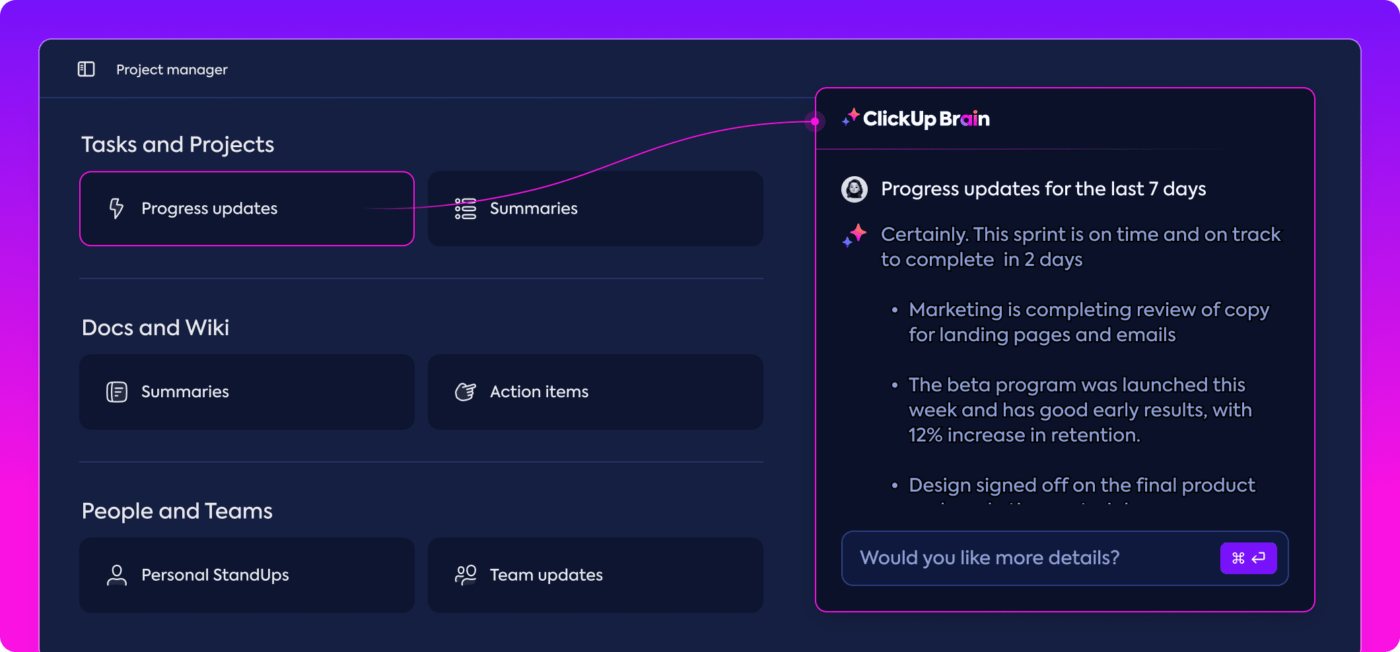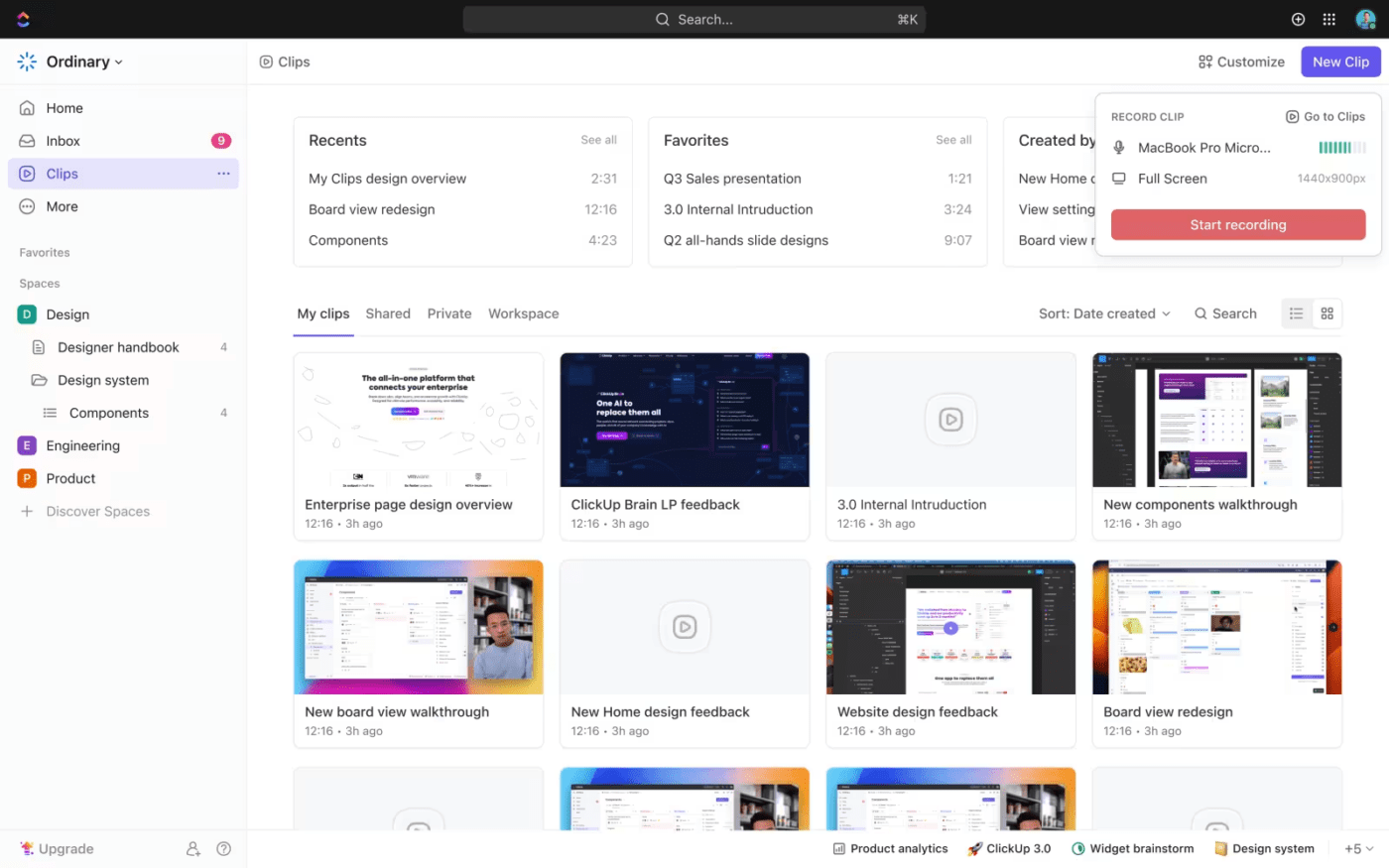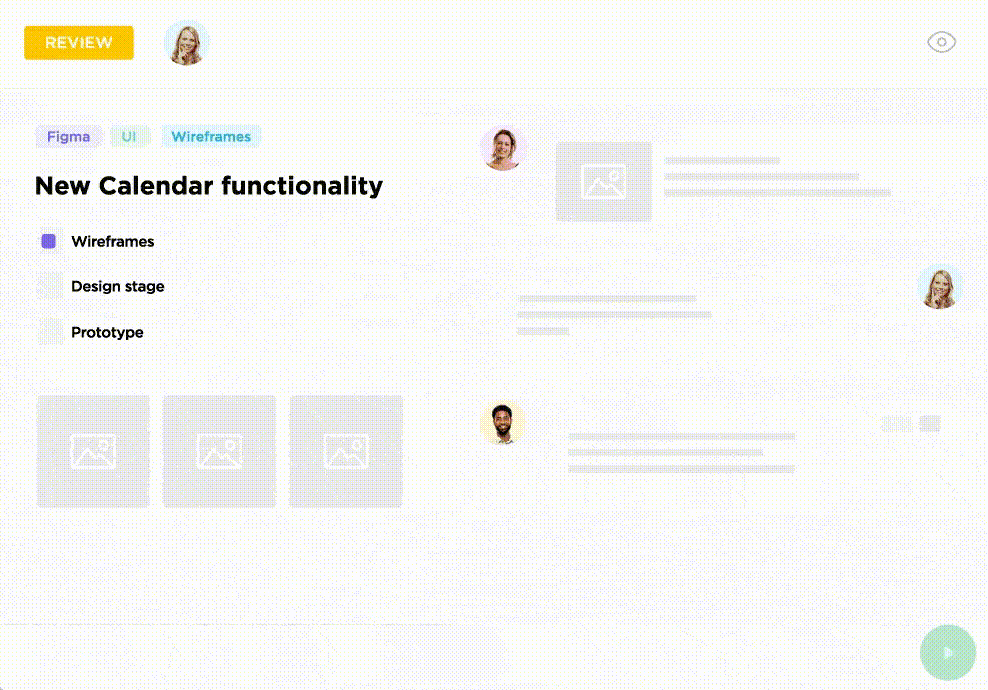تعد إنتاجية العامل كائنًا أسطوريًا في أي مؤسسة - كيف نعرف أن شخصًا ما منتج بالفعل؟ لذا، أنشأنا نقاط تفتيش، مثل الاجتماعات المتزامنة، والتواجد في المقصورة، واستراحات الغداء الموقوتة، وروتين 9-5.
لكن الزمن تغير. لم يعد العمل المتزامن داخل المكتب هو النوع الوحيد من العمل. يسعى العاملون اليوم إلى مزيد من المرونة، ليس فقط في ساعات عملهم، ولكن أيضًا في طريقة عملهم.
كقائد عمل أو مدير أو متخصص في الموارد البشرية، كيف يمكنك تنفيذ استراتيجيات لمساعدتهم؟ دعنا نكتشف ذلك.
ما هو العمل غير المتزامن؟
العمل غير المتزامن هو أسلوب عمل يعمل فيه الموظفون وينجزون المهام ويتواصلون مع زملائهم في الوقت الذي يختارونه.
بشكل أساسي، لا تتزامن ساعات عمل كل فرد في الفريق مع الآخر، ومن ثم فهو غير متزامن.
كيف يبدو مكان العمل غير المتزامن؟
لا يعني عدم التزامن بالضرورة أن يكون الجميع عاملين عن بُعد أو أن يكونوا جميعًا في أجزاء مختلفة من العالم. إنه يعني ببساطة أن كل شخص لديه الحرية في تصميم كيف وأين ومتى يعمل.
يتميز العمل غير المتزامن بما يلي.
- يتمتع الموظفون بالمرونة للعمل عن بُعد
- يصممون ساعات عملهم بما يتناسب مع حياتهم وعاداتهم ودورات إنتاجيتهم
- تتواصل الفرق من خلالأدوات العمل عن بُعدوالمستندات التعاونية ورسائل البريد الإلكتروني وأنظمة إدارة المشاريع (بدلاً من الاجتماعات الفردية في الوقت الفعلي)
- هم من يقررون القواعد والحدود والرموز التي تحكم عملهم غير المتزامن
- أيالتعاون في الوقت الحقيقي يتم جدولتها مسبقًا وتحسينها لتحقيق أقصى قدر من الإنتاجية
باختصار، العمل غير المتزامن يفصل الإنتاجية عن الرؤية والتوافر. كما يقول تايلر غيليسبي، المؤسس والعامل غير المتزامن، في مدونته على التواصل غير المتزامن يشير إلى أن العمل غير المتزامن هو "شهادة على حقيقة أن الموظفين وأعضاء الفريق هم أشخاص بالغون لا يحتاجون إلى المراقبة أو الإدارة باستمرار."
باختصار، أنت لست بحاجة إلى الجلوس في مقصورتك لكي يُنظر إليك على أنك تعمل!
كيف يشكل العمل غير المتزامن سوق العمل؟
بطبيعة الحال، يتطلب العمل غير المتزامن تحولًا كبيرًا في الثقافة والنسيج العاطفي للمؤسسة بأكملها.
يحتاج الموظفون إلى إدارة ذاتية، ويحتاج المديرون إلى أن يكونوا أكثر ثقة بالموظفين الذين لا يرونهم بشكل منتظم أو لم يروهم على الإطلاق.
وقد أجبرت فجوة المواهب الآخذة في الاتساع، خاصة في العمل المعرفي، المديرين على قبول وتشجيع العمل غير المتزامن.
فهم العمل غير المتزامن
العمل غير المتزامن يفصل الإنتاجية عن التواصل المستمر. يساعد العمل غير المتزامن على إنجاز العمل بأقل قدر ممكن من التعطيل دون الحاجة إلى استجابة أو رد فعل فوري. في هذا النمط من العمل يحترم الزملاء الاستقلالية ويقدرون قيمة المرونة في مكان العمل .
حسنًا، كيف تختلف عن العمل التقليدي (الذي نسميه العمل المتزامن)؟ لنكتشف ذلك.
العمل المتزامن مقابل العمل غير المتزامن: كيف يختلف؟ العمل غير المتزامن والعمل المتزامن هما نموذجان تشغيليان يختلفان في المقام الأول على مدى توفر أعضاء الفريق في وقت معين. عادةً ما يكون العمل المتزامن من 9-5 عندما يكون الجميع في المكتب أو متاحًا عبر الإنترنت.
أما العمل غير المتزامن فيحدث عندما تحدد الفرق أهدافها ومعايير القبول معًا ثم ينصرفون للقيام بجزء من العمل في الوقت والمكان الخاص بهم. يتجلى هذا الاختلاف بطرق مختلفة.
| السمة | العمل غير المتزامن | العمل المتزامن |
|---|---|---|
| نموذج العمل | يمارس الموظفون استقلالية المكان والزمان | حتى الفرق الموزعة تتعاون في الوقت الفعلي وتعمل معًا |
| التواصل | من خلال أدوات إدارة المشاريع، ورسائل البريد الإلكتروني، والرسائل، وما إلى ذلك. | شخصيًا أو عبر مكالمات الفيديو/المكالمات الصوتية المباشرة |
| الإدارة | إدارة ذاتية للغاية | يلعب المدراء دوراً كبيراً |
| وقت الاستجابة | متفق عليه بشكل جماعي من قبل الفريق | الاستجابة الفورية المتوقعة |
| الثقة | ثقة عالية واستقلالية | ثقة منخفضة (مع المراقبة) |
الاختلافات بين العمل غير المتزامن والعمل المتزامن
ما هي الطرق التي يكون بها العمل غير المتزامن أفضل؟
تخيل موقفًا في المكتب: تقوم بتسجيل الدخول، وتنتهي المجاملات، ويطلب منك أحد الزملاء جزءًا من المحتوى. تبدأ العمل عليه.
دق دق؛ يقاطعك زميل آخر يمر بجانب مكتبك ويريد مناقشة تقرير تحليلات جوجل الشهري. تلقي نظرة خاطفة على الأرقام وتقوم ببعض العمليات الحسابية الذهنية عندما يصدر صوت بينغ!
مديرك يريد منك إجراء مكالمة سريعة معه. تقوم بإعادة ترتيب أولويات بعض المهام ومناقشة بعض القضايا المتعلقة بالأشخاص في فريقك؛ وقبل أن تدرك ذلك، يحين وقت الغداء.
الملخص: بينما كنت مشغولاً، تبقى قائمة أعمالك الأصلية دون أن تمسها.
في حين أن هذا يمكن أن يحدث في العمل غير المتزامن أيضًا، إلا أن الأنظمة توفر تكتيكات وأساليب معينة لمنع ذلك.
إيقاف الإشعارات: يمكنك إيقاف تشغيل إشعارات Slack والتركيز على مهامك. (لا يمكنك تجنب مرور أحد الزملاء في _المكتب!)
تخطيط يومي أفضل: يمكنك تخصيص وقت للتحقق من الرسائل أو رسائل البريد الإلكتروني حتى لا يتشتت انتباهك أثناء القيام بعمل عميق. (كيف تخطط للنقرات على الكتف؟) (كيف تخطط للنقرات على الكتف؟)
توقعات مُدارة: لا تتوقع فرق العمل غير المتزامنة ردوداً فورية، مما يسهل عليك رفض الأشياء، إذا لزم الأمر (من الصعب جداً أن تقول لا لشخص يطلب منك شخصياً إجراء "دردشة سريعة")
أنظمة مبنية لغرض معين: تمتلك فرق العمل غير المتزامنة أيضًا وثائق وإدارة مشاريع وأدوات أخرى لضمان أن تكون المعلومات مفتوحة ومتاحة لأي شخص يحتاج إليها. (ليس من الضروري أن تكون أنت من يجيب على جميع الأسئلة)
إدارة التقويم: يمكنك جدولة "ساعات التواصل" مثل ساعات عمل الأساتذة للإشارة إلى الأشخاص عندما تكون متاحًا للاتصالات. (القيام بذلك في المكتب قد يبدو باهظ الثمن)
العمل غير المتزامن هو عبارة عن نقرة على الكتف تظل معلقة حتى تقوم أنت أو زميلك بتسجيل الدخول أو البدء في كتابة المستندات عبر مناطق زمنية مختلفة.
مكافأة على القراءة: كيف يغير العمل غير المتزامن التعاون هل هذا يعني أن جميع الأعمال غير المتزامنة قاتلة للإنتاجية؟ لا!
ليست كل الاتصالات المتزامنة غير ضرورية. هناك العديد من الحالات التي يكون فيها التعاون في الوقت الفعلي ضروريًا لتوحيد جهود الفرق في نفس الصفحة.
متى يكون العمل المتزامن وغير المتزامن مناسبًا؟
يكون العمل المتزامن هو الأفضل عندما يكون التواصل في الوقت الفعلي ضروريًا، مثل:
- مراجعات الفريق: يساعد التواجد شخصيًا في الوقت الفعلي على معالجة الجوانب العاطفية والإنسانية للملاحظات بشكل أفضل
- جلسات العصف الذهني: يساعد التواجد المتزامن على البناء على أفكار بعضنا البعض في بيئة مغلقة
- التفكير العرضي: يمكن أن تؤدي لحظة عابرة، أو لحظة عابرة، إلى اختراقات كبيرة إذا عملت الفرق بشكل متزامن
- الإقناع: من غير المحتمل جداً أن تتمكن من إقناع عميل محتمل بالشراء أو عميل غاضب بالبقاء دون تفاعل فردي
- ورش العمل: التعلم بالممارسة يتم بشكل أفضل شخصياً وفي الوقت الفعلي. وهذا ينطبق بشكل خاص على المهام التي تحتاج إلى شخصين أو أكثر للعمل معًا
يكون العمل غير المتزامن أفضل عندما تحتاج الفرق إلى مساحة للقيام بعمل مركّز، مثل:
المهام غير المتزامنة: يمكن إرسال التحديثات حول العمل المنجز، والعمل قيد التنفيذ، والمعيقات بشكل غير متزامن. في الواقع، باستخدام أداة مثل ClickUp Brain يمكنك أتمتة ذلك بناءً على مدخلات اليوم السابق.

أتمتة تحديثات الموقف باستخدام ClickUp Brain
الإنشاء معاً: بمجرد الاتفاق على موضوع ما، يمكنك كتابة المقال بشكل غير متزامن. يمكن لعدة أشخاص إدخال عملهم في مستند مشترك وتحريره بشكل مستقل.
إدارة المشروع: يمكن لمدير المشروع القيام بمعظم عمله بشكل غير متزامن. على سبيل المثال، يمكنهم تعيين المهام، وبناء سير العمل، وإرسال الملاحظات الصوتية/النصية وما إلى ذلك، دون التواجد مع أعضاء الفريق.
تأهيل الموظفين الجدد: لقد ولّت الأيام التي كنت تقوم فيها بمرافقة الموظف الجديد خلال كل خطوة. أما اليوم، فيمكنك إعداد وثيقة تأهيل واضحة وشاملة يمكن للموظف الجديد أن يطلع عليها بنفسه!
إذا كنت تتبع نموذجًا يجمع بين الاثنين، فإليك كيف يمكنك جعل التواصل الهجين في مكان العمل فعّال
والآن بعد أن فهمنا ما هو العمل غير المتزامن وكيف يختلف عن النماذج التقليدية، إليك السبب الذي يجعلك تتبناه بكل إخلاص.
أهمية العمل غير المتزامن في ثقافة العمل اليوم
لم يعد بإمكان قادة الأعمال ومتخصصي الموارد البشرية تجنب هياكل العمل غير المتزامن لعدة أسباب.
تفضيل الباحث عن عمل الدراسات أن حوالي 98% من القوى العاملة ترغب في العمل عن بُعد، على الأقل بدوام جزئي. ومن المرجح أن يكون الموظفون من جيل Z أكثر ميلاً إلى العمل عن بُعد، كما أن المرونة تجذب النساء في القوى العاملة.
الترحال الرقمي
يفضل العديد من العاملين في مجال المعرفة الحديثة العمل أثناء سفرهم. لا تتوفر بعض المهارات الأكثر تخصصاً والأعلى أجراً إلا لدى أولئك الذين يرغبون في الاستقلالية في الموقع والوقت. بالنسبة لهم، فإن العمل غير المتزامن و أدوات الترحال الرقمي تصبح أساسية للفعالية.
سياسات الإجازات البديلة
حتى الآن، كان يتم أداء وظيفة واحدة بدوام كامل من قبل شخص واحد بدوام كامل، وكان يتم تخصيص عدد محدد من الأيام كإجازة مدفوعة الأجر. أما اليوم، فيريد الموظفون المزيد من المرونة. فهم يسعون إلى الحصول على إجازات تفرغ وإجازات طويلة لمتابعة اهتمامات أخرى.
وقد أدى ذلك إلى ظهور تقاسم الوظائف، والذي يتيح لموظفين اثنين تقاسم مسؤولية وظيفة واحدة بدوام كامل. و الممارسة أصبحت شائعة في شركات المحاماة، حيث يقوم المستشارون بتقسيم المهام وفقًا للحاجة الملحة ويتحملون مسؤولية مهام محددة.
ويساعد ذلك الموظفين على تقاسم العمل والوقت، مما يضمن قيام شخص ما بتغطية المهام. تعني هذه المرونة أيضًا تقليل الاعتماد على موظف واحد، مما يقلل من الاختناقات بسبب التبعيات.
ميزة تنافسية
تفكر كل مؤسسة في العمل عن بُعد/المختلط هذه الأيام. لدى AirBnB العيش والعمل في أي مكان السياسة مزود البحث على الإنترنت DuckDuckGo لديها موظفون في 15 دولة. تحتاج إلى أن تكون شركة غير متزامنة لجذب أفضل المواهب في سوق اليوم التنافسي.
فجوة المواهب
وبالحديث عن فجوة المواهب، يمكن للمؤسسة التي ترتاح للعمل غير المتزامن أن توظف من أي مكان في العالم. وهذا يمكن أن يكون فعالاً من حيث التكلفة ويحقق فوائد كبيرة على المدى الطويل.
إذا كان ذلك يبدو جذاباً (أو حتمياً)، فإليك كيفية تطبيق ممارسات العمل غير المتزامن في مؤسستك.
تنفيذ العمل غير المتزامن: أفضل الممارسات
من الناحية النظرية، العمل غير المتزامن أمر بسيط - دع الناس يديرون أنفسهم وعملهم بالطرق الأنسب لهم. في الممارسة العملية، يمكن أن يؤدي ذلك إلى الفوضى.
لتنفيذ العمل غير المتزامن بسلاسة، تحتاج إلى أشخاص وعمليات وتكنولوجيا لا تمكّن الموظفين فحسب، بل أيضاً المديرين والموارد البشرية وما إلى ذلك. دعنا نرى كيف يمكنك الاستفادة من أفضل ثماني ممارسات لضمان النجاح.
1. تحديد أبطال العمل غير المتزامن
لا يمكنك إنجاز أي شيء إذا لم يؤمن به الناس ويتعاطفون معه. لتمكين ذلك، تحتاج إلى معرفة نبض جمهورك.
- قم بإجراء استبيانات لفهم ما إذا كانت فرقك تريد العمل غير المتزامن;نماذج ClickUp طريقة رائعة للقيام بذلك
- اسأل عما إذا كانوا بحاجة إلى وقت عمل مرن فقط أو موقع مرن أيضًا
- تعرف على أساليب عملهم الحالية ومستويات إنتاجيتهم

طريقة عرض نموذج النقر فوق النموذج للاستطلاعات
بعد ذلك، حدد الأعضاء المتحمسين بشكل خاص في فريقك الذين سيدافعون عن القضية بين البقية. قم بتمكينهم بالأدوات والعمليات اللازمة لتعزيز إدارة التغيير.
2. إنشاء الأنظمة
تحتاج فرق العمل عن بُعد أيضاً إلى مكان عمل مشترك، باستثناء الافتراضي. قم بتمكين مساحة عمل افتراضية شاملة ومتعددة الأوجه لفريقك. منصة العمل المتكاملة من ClickUp للعمل عن بُعد تمنحك كل ما تحتاجه لتشغيل العمل عن بُعد:
- المشاريع والمهام
- طرق عرض متعددة
- تتبع الإنتاجية
- إدارة الأداء
- التوثيق
- الأتمتة
3. توحيد الاتصالات
تأكد من أن أي نظام تقوم بإعداده يتيح التواصل غير المتزامن وتبادل الأفكار والتعاون بشأن عناصر العمل.
يتضمن ClickUp عددًا من اتصال غير متزامن أيضًا. مهام ClickUp يحتوي على تعليقات متداخلة للفرق لمناقشة/مناقشة الأفكار في السياق. ClickUp Whiteboard والخرائط الذهنية تجعل التعاون الافتراضي مرئيًا وفعالًا. عرض دردشة ClickUp مصممة خصيصًا للعمل غير المتزامن، حيث تجمع كل الرسائل تحت نافذة واحدة. لستَ بحاجة إلى القفز عبر الأطواق للعثور على الرسائل التي تُقدَّم لك جميعًا لمراجعتها واتخاذ إجراء بشأنها عندما تكون مستعدًا.

النقر فوق عرض المحادثة لإلقاء نظرة موحدة على جميع الرسائل
4. تجاوز الرسائل النصية
عند إرسال الرسائل النصية، خاصةً بين الأشخاص الذين يتحدثون لهجة مختلفة أو ينتمون إلى ثقافة مختلفة، يمكن أن يُساء فهم نبرة صوتك. لذا، قم بخلق فرص للتواصل عبر الرسائل النصية والصوتية والمرئية وغيرها.
على سبيل المثال مقاطع كليك أب بمشاركة تسجيلات الشاشة على الفور وتقديم ملاحظات صوتية. فبدلاً من إجراء مكالمة فيديو (والتي تحتاج إلى توافر مشترك، يمكنك إنشاء مقطع فيديو يمكن للمتلقي مشاهدته لاحقاً.
باستخدام Clip، يمكنك أيضًا:
- نسخ التسجيلات ونسخ المقتطفات
- إضافة تعليقات داخل الفيديو وبدء محادثات عبر جدول زمني
- تحويل وصف المقاطع إلى قائمة مهام فعلية
- البحث في النصوص عن نقطة معينة

_مركز تسجيل الشاشة ومقاطع الفيديو _ClickUp Clips
5. إدارة التوقعات
اجمع الفريق معًا لوضع حواجز حماية وتوقعات لبعضهم البعض. وقد يشمل ذلك اتخاذ قرارات بشأن:
- متى يجب الرد على رسالة ما؟
- في أي منطقة زمنية يتم تحديد المواعيد النهائية؟
- متى يمكننا طلب إجراء محادثات في الوقت الفعلي؟
- أين وكيف يجب تقديم الملاحظات؟
قم بإنشاء ميثاق عمل غير متزامن لفريقك/منظمتك على مستندات ClickUp . شارك مع كل من يهمه الأمر. ادعهم للتعليق/إبداء الملاحظات. تطور أثناء تقدمك!

وثّق بدقة وتعاون بفعالية مع مستندات ClickUp Docs
6. تتبع الإنتاجية
على الرغم من أن فرق العمل قد لا تحب أن تتم مراقبتهم بشأن ما يفعلونه، ومتى يعملون، وما إلى ذلك، إلا أن تتبع الإنتاجية يساعد المؤسسة. شجع أعضاء الفريق على:
- استخدامتتبع وقت ClickUp لتسجيل ساعات عملهم
- تعيين التوافر بوضوح حتى يتمكن مدير المشروع من تعيين المهام وفقًا لذلك
- إجراء تقديرات زمنية شبه دقيقة للمهام المسندة إليهم

ClickUp تتبع الوقت
تتبّع أيضًا مقدار الوقت المستغرق في الاجتماعات ورسائل البريد الإلكتروني ورسائل الدردشة وجلسات Slack وما إلى ذلك لقياس تأثير الإنتاجية من الانتقال إلى العمل غير المتزامن.
7. منع التفكير الجماعي
التفكير الجماعي، ببساطة، هو إجماع غير نقدي على شيء ما لأن الناس يريدون تجنب المواجهة. يمكن أن تكون هذه مشكلة أكبر في فرق العمل عن بُعد لأنه من الأسهل على أولئك الذين يختلفون في الرأي أن يلتزموا الصمت.
لمنع حدوث ذلك:
- شجع الجميع على التحدث
- ضع علامة على الأشخاص وادعهم لتقديم تعليقاتهم
- قم بتدريب بطل العمل غير المتزامن (تذكر من الخطوة 1؟) لحث الأشخاص الصامتين على المساهمة
- عند الضرورة القصوى، قم بإنشاء طرق لمدخلات مجهولة من خلال النماذج واستطلاعات الرأي
8. دمج العمل وسير العمل
تستخدم معظم الفرق عدة أدوات لإنجاز عملها. إن دمج أدوات الاتصال غير المتزامن بشكل فعال يجعل العمل أسهل.
على سبيل المثال، يمكنك دمج Zoom مع ClickUp لبدء المكالمات مباشرةً من منصة إدارة المشروع. مع تكامل Slack، يمكنك إخطار أشخاص محددين بتغيير في حالة المهمة. تدمج فرق البرمجيات أدوات مثل GitHub و LambdaTest، وما إلى ذلك، لجعل سير العمل سلساً.

تقدم ClickUp تكاملاً مع أكثر من 1000 أداة لجعل عملك سلسًا
على الرغم من بذل قصارى جهدك، لا مفر من التحديات. دعنا نرى ما قد تواجهه وكيف يمكنك التغلب عليها.
العمل غير المتزامن: التحديات والقيود
لقد رأينا أن التعاون غير المتزامن يوفر العديد من المزايا ويفضلها بشدة الفرق الحديثة. ومع ذلك، فإن العمل غير المتزامن في حد ذاته ليس النهج الأفضل لجميع الحالات. إليك السبب وكيف يمكنك التغلب على هذه القيود.
إجهاد التكبير والإخطار الزائد
قد يتسبب عدم العمل في نفس البيئة المادية في أن يتصل الأشخاص ببعضهم البعض كثيرًا أو يطلبون الكثير من الاجتماعات. يمكن أن يؤدي ذلك إلى إبطال الغرض من العمل بشكل غير متزامن.
الحل
بناء ثقافة التوثيق في المؤسسة. شجع الفرق على تسجيل الأفكار الرئيسية وعمليات التفكير والآراء وغير ذلك حتى يتمكن الأشخاص من الوصول إليها متى احتاجوا إلى ذلك. استخدم ذلك لإنشاء سير عمل غير متزامن يجعل الحياة أسهل للجميع على المدى الطويل.
التواصل عبر المناطق الزمنية
هل سبق لك أن أرسلت "مرحباً" وبحلول الوقت الذي يرد فيه المتلقي، تكون قد نسيت ما تريد؟ يمكن أن يحدث هذا في كثير من الأحيان عندما تعمل الفرق عبر المناطق الزمنية.
الحل:
- حدد ساعات العمل المشتركة لجدولة مكالمات الفيديو الهامة والتواصل في الوقت الفعلي ومهام تسليم المشروع
- ضع توقعات واضحة حول موعد وكيفية رد أعضاء الفريق على رسائل بعضهم البعض
- ضع قوالب وأطر عمل للمحادثات - على سبيل المثال، شجع الجميع على تقديم السياق وطرح السؤال كاملاً بدلاً من "مرحباً"
مشاركة الفريق
يمكن أن تؤثر العزلة الناجمة عن كونك تعمل عن بُعد وعدم التفاعل وجهاً لوجه مع الأقران على التحفيز. وسرعان ما يفقد أعضاء الفريق إحساسهم بالهدف والمواءمة مع الأهداف التنظيمية.
الحل: تضمين مشاركة الفريق في مجالات المسؤولية الرئيسية للمديرين (KRAs). قم بتضمين أنشطة الترابط والمرح بين الحين والآخر. (يمكنك حتى أن تطلب من أعضاء فريقك مشاركة صورة القطط الخاصة بهم - وهذا ينجح دائمًا!)
الاستعجال مقابل المرونة
العمل عن بُعد يعني أن أعضاء الفريق قد لا يفهمون مدى إلحاح بعض المشكلات أو تأثيرها. على سبيل المثال، يجب التعامل مع تذكرة "الأولوية الأولى" على الفور، وهو ما قد لا يتوفر أي شخص متاح لفريق مرن.
الحل: خطط جدولك الزمني المرن لضمان الوفاء باتفاقيات مستوى الخدمة (SLAs). إذا كنت بحاجة إلى أعضاء الفريق المتاحين في أوقات معينة، فحدد ذلك مبكراً وقم بجدولة المواعيد وفقاً لذلك.
فعالية التدريب
حتى مع ازدياد شعبية التعلم الفردي الذاتي حسب الوتيرة الذاتية، إلا أنه غالباً ما لا يكون الأكثر فعالية. يكاد يكون من المستحيل توثيق أو نقل المعرفة الضمنية داخل بيئة العمل. ويساعد العمل في نفس المكتب على نمذجة السلوكيات التي قد يكون من الصعب القيام بها بشكل غير متزامن.
الحل: بناء وحدات تعليمية عملية المنحى. اجمع الفرق معًا للتعلم من بعضها البعض. اجعل خطط الدروس تفاعلية. لا تتوقف عند الإعداد الأولي - قم بإنشاء سبل لتدريب أعضاء الفريق وإعادة تدريبهم بانتظام.
قم بإتقان العمل غير المتزامن مع ClickUp
سواء كنت تعمل بشكل متزامن أو غير متزامن، فإن الإنتاجية غالبًا ما تكون أسطورية، مثل وحيد القرن أو قطط شيشاير. في بيئات العمل التقليدية، كانت علامة الإنتاجية في بيئات العمل التقليدية هي الظهور، والتواجد على الإنترنت، والجلوس في مقصوراتهم، والتحدث في الاجتماعات، وما إلى ذلك.
أما في عالم العمل غير المتزامن، فإن الرؤية تأخذ مقعداً خلفياً. ولجعلها عملية، تحتاج فرق العمل غير المتزامنة إلى طريقة جديدة جذرية لإدارة عملها وتواصلها وأدائها.
تم تصميم برنامج إدارة المشاريع من ClickUp لتمكين ذلك بالضبط. مع اللوحات البيضاء، والخرائط الذهنية، والمحادثات في الوقت الفعلي، وإدارة المهام، والمستندات، ولوحات المعلومات وغيرها، سيغير ClickUp عمل فريقك.
انظر بنفسك. جرّب ClickUp اليوم !

